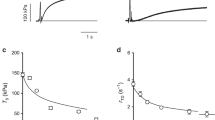Abstract
Inorganic phosphate (Pi) accumulates extremely rapidly in ischaemic heart muscle and intracellular binding of this metabolite may account for the precipitous loss of function seen at the onset of severe ischaemia. We have used31P-NMR spectroscopy to measure the free cytosolic [Pi] and chemical assay techniques to measure total tissue Pi at 0, 1, 2, 3, 5, and 12 min of complete global ischaemia in the isolated isovolumic rat heart. At zero time, the Pi assayed chemically was 30.77±5.52 μmol/g dry wt (mean±SD, n=7) whilst Pi assayed by NMR was 3.39±1.21 μmol/g dry wt (n=15). Thus, 27.38 μmol/g dry wt of Pi was bound at a cytosolic [Pi] of 0.82 mM. After 12 min of ischaemia, 49.88 μmol/g dry wt of Pi was bound at a cytosolic [Pi] of 4.11 mM. When all data were fitted, using a non-linear, least squares fit (p<0.05), to the binding isotherm: Bound Pi=B′max. [Pi]/(K′d+[Pi]), the apparent binding parameters K′d and B′max were estimated to be 1.1±0.6 mM and 64.0±10.2 μmol/g dry wt respectively. During the first minute of global ischaemia when the rate-pressure product had decreased by 79% of its pre-ischaemic value, bound Pi had increased by 58% and free cytosolic [Pi] by 162%. When functional and metabolite changes were expressed as a fraction of the total change which occurred during the 12-min ischaemic period, bound Pi had the profile most similar to the rate-pressure product. Both the amount of bound Pi and free cytosolic [Pi] correlated with loss of contractile function as the ischaemic period progressed. The results snow that during ischaemia, Pi is bound progressively as free cytosolic [Pi] is increased as the result of high energy phosphate hydrolysis. While these results are consistent with the possibility that Pi binding may contribute to ischaemic contractile failure, no molecular explanation for the possible effect of bound Pi on contraction has been propsed.
Similar content being viewed by others
References
Armiger LC, Elliot TB, Fitzgerald S, Humphrey SM, Morrison MA, Seelye RN (1983) Effects of proton release from adenine nucleotide degradation during ischemic necrosis of myocardium in vitro. Biochem Med 29: 265–277
Armiger LC, Humphrey SM, West EJN, Knell CM (1986) The effects of raised phosphate level on the energy metabolism, contractile function, and fine structure of oxygenated and oxygen deficient myocardium. Heart Vessels 2: 6–14
Brooks WM, Willis RJ (1985) Determination of intracellular pH in Langendorff-perfused guinea-pig heart by31P nuclear magnetic resonance spectroscopy. J Mol Cell Cardiol 17: 747–752
Clarke K, O'Connor AJ, Willis RJ (1987) Temporal relation between energy metabolism and myocardial function during ischemia and reperfusion. Am J Physiol 253: H412-H421
Elliott AC, Smith GL, Eisner DA, Allen DG (1992) Metabolic changes during ischaemia and their role in contractile failure in isolated ferret hearts. J Physiol 454: 467–490
Garlick PB, Brown TR, Sullivan RH, Ugurbil K (1983) Observation of a second phosphate pool in the perfused heart by31P NMR: is this the mitochondrial phosphate? J Mol Cell Cardiol 15: 855–858
Headrick JP, Armiger LC, Willis RJ (1990) Behaviour of energy metabolites and effects of allopurinol in the “stunned” isovolumic rat heart. J Mol Cell Cardiol 22: 1107–1116
Headrick JP, Dobson GP, Williams JP, McKirdy JC, Jordan LR, Willis RJ (1994) Bioenergetics and control of oxygen consumption in the in situ rat heart. Am J Physiol 267: H1074-H1084
Hearse DJ, Garlick PB, Humphrey SM (1977) Ischemic contracture of the myocardium: Mechanisms and prevention. Am J Cardiol 39: 986–993
Holliss DG, Humphrey SM, Morrison MA, Seelye RN (1984) Reverse phase HPLC for rapid comprehensive measurement of nucleotides, nucleosides and bases of the myocardial adenine pool. Anal Lett B 18: 2047–2064
Humphrey SM, Armiger LC, Holliss DG, Buckman JE (1988) Functional and metabolic responses of the isolated rat heart to changes in circulating inorganic phosphate concentration. Heart Vessels 4: 207–214
Humphrey SM, Buckman JE, Holliss DG (1990) Subcellular distribution of energy metabolites in the pre-ischaemic and post-ischaemic perfused working rat heart. Eur J Biochem 191: 755–759
Humphrey SM, Garlick PB (1991) NMR-visible ATP and Pi in normoxic and reperfused rat hearts: a quantitative study. Am J Physiol 260: H6-H12
Ingwall JS (1982) Phosphorus nuclear magnetic resonance spectroscopy of cardiac and skeletal muscles. Am J Physiol 242: H729-H744
Kammermeier H, Schmidt P, Jüngling E (1982) Free energy change of ATP-hydrolysis: a causal factor of early hypoxic failure of the myocardium? J Mol Cell Cardiol 14: 267–277
Kentish JC (1986) The effects of inorganic phosphate and creatine phosphate on force production in skinned muscles from rat ventricle. J Physiol 370: 585–604
Koretsune Y, Corretti MC, Kusuoka H, Marban E (1991) Mechanism of early ischemic contractile failure. Inexcitability, metabolite accumulation, or vascular collapse? Circ Res 68: 255–262
Kusuoka H, Weisfeldt ML, Zweier JL, Jacobus WE, Marban E (1986) Mechanism of early contractile failure during hypoxia in intact ferret heart: Evidence for modulation of maximal Ca++-activated force by inorganic phosphate. Circ Res 59: 270–282
McClellan G, Weisberg A, Winegrad S (1983) Energy transport from mitochondria to myofibril by a creatine phosphate shuttle in cardiac cells. Am J Physiol 245: C423-C427
Orchard CH, Kentish JC (1990) Effects of changes in pH on the contractile function of cardiac muscle. Am J Physiol 258: C967-C981
Takami H, Furuya E, Tagawa K, Seo Y, Murakami M, Watari H, Matsuda H, Hirose K, Kawashima Y (1988) NMR-invisible ATP in rat heart and its change in ischaemia. J Biochem (Tokyo) 104: 35–39
Author information
Authors and Affiliations
Rights and permissions
About this article
Cite this article
Armiger, L.C., Headrick, J.P., Jordan, L.R. et al. Bound inorganic phosphate and early contractile failure in global ischaemia. Basic Res Cardiol 90, 482–488 (1995). https://doi.org/10.1007/BF00788541
Received:
Revised:
Accepted:
Issue Date:
DOI: https://doi.org/10.1007/BF00788541




